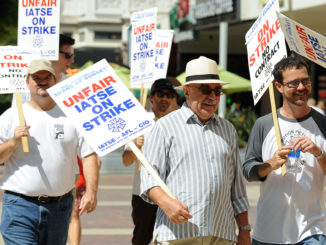
Reprinted from The Manchester Guardian by John Naughton on August 22 2020.
“Last Monday, the superior court of California handed down a landmark judgment that looks like taking the wind out of the sails of at least some parts of the ‘gig economy,’ writes John Naughton in The Guardian. “The case was brought by the attorney general of the state of California, together with the city attorneys of Los Angeles, San Diego and San Francisco, on the basis that the ride-hailing companies Uber and Lyft have ‘misclassified their drivers as independent contractors rather than employees’ in violation of a Californian law that took effect in January. This statute is intended to ensure that all workers who meet its criteria receive the basic rights and protections guaranteed to employees under California law.
“The companies opposed this idea, for the understandable (but of course unstated) reason that complying with the law would blow their business models to smithereens. In submissions concealed under three coats of prime legal verbiage, they sought to have the hearing delayed until after the November presidential election, complained that the attorneys general should not have lumped them together (they are, after all, commercial rivals) and that judgment should be deferred until all the other cases concerning them in the US and elsewhere should be decided.
“Judge Ethan Schulman was not impressed by these arguments. The US supreme court, he pointed out, had produced three tests for deciding whether someone was an independent contractor or not. They are that the person a) should be ‘free from the control and direction of the hiring entity’; b) ‘performs work that is outside the usual course of the hiring entity’s business’; and c) ‘is customarily engaged in an independently established trade, occupation or business of the same nature as that involved in the work performed.’ Since it was self-evident that the defendants couldn’t satisfy criterion b, the judge declared: ‘The likelihood that the People will prevail on their claim that the Defendants have misclassified their drivers is overwhelming.’ QED. …
Slate: Uber, Lyft Considering a Franchise Model; It Won’t Fix Their Problems
Reprinted from Slate by Brian Callaci on August 24, 2020.
Last week Uber and Lyft threatened to shut down in California if they were forced to comply with a law that would require them to classify their freelance drivers as employees. An appeals court granted the companies a temporary reprieve on Thursday, allowing them to operate with independent contractors while they fight the court order. However, the companies are already preparing for the day of reckoning should they lose their legal battle and reportedly considering switching to a franchise model. Under the plan, the companies would license their brand names and technology to owners of traditional taxi fleets. The fleet owners would employ the drivers, allowing Uber and Lyft to continue to avoid the costs associated with employment.
Should they go through with the plan, it would actually represent a return to the roots of the gig economy, which began with older business models like franchising. It would also emphasize that addressing misclassification issues is not enough. The problem of large corporations using legal strategies to skirt laws protecting workers goes far beyond misclassification and the so-called gig economy. The essence of the gig economy is control without responsibility: Uber and Lyft use electronic surveillance and algorithmic carrots and sticks to coordinate the activity of drivers, without triggering the legal responsibilities and costs that go with employment. Gig companies argue that despite being subject to this algorithmic control, each driver is not an employee but rather an entrepreneur running an independent business.
Uber and Lyft can pull this off because they are following in the footsteps of franchisors like McDonald’s and Jiffy Lube, which decades ago pioneered the legal mechanisms of gaining control over far-flung business empires without triggering legal employment relationships. These mechanisms, known in antitrust law as vertical restraints, are contract terms that minutely prescribe the product offerings, hours of operation, and even the precise way cashiers greet the customer for each unit in a franchised chain. Vertical restraints are why every McDonald’s looks the same, even though most of them are owned by independent franchisees. During the initial franchising boom in the 1960s, many legislators and courts were hostile to the idea of large corporations dictating to independent small businesses how they must run their businesses. As a congressional staffer put it to a franchisor during a 1965 hearing, “if [a franchisee] is told what product he has to buy, what prices he has to charge, what operation he has to operate in, then he is no longer independent, is he?” As is happening now with Uber and Lyft, the ensuing congressional hearings, Federal Trade Commission investigations, and court cases debated whether franchising would become a viable business model. In 1977, a landmark court case between a television manufacturer and its franchisee, Continental TV v. GTE Sylvania, decided the issue of vertical restraints in favor of franchisors. Henceforth, franchisors would have wide latitude to impose contractual controls on nominally independent businesses. Uber and Lyft would follow in their footsteps. …






